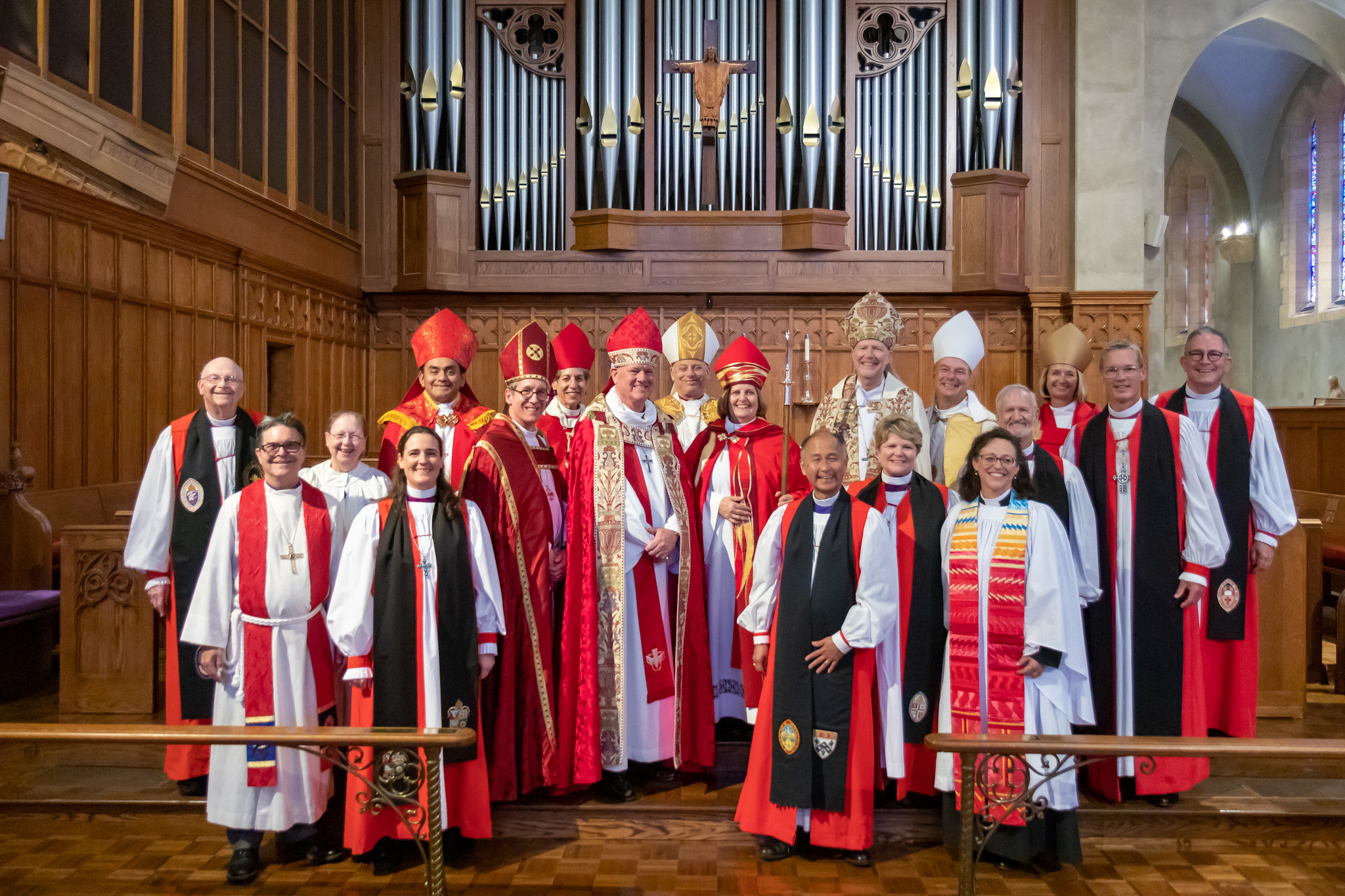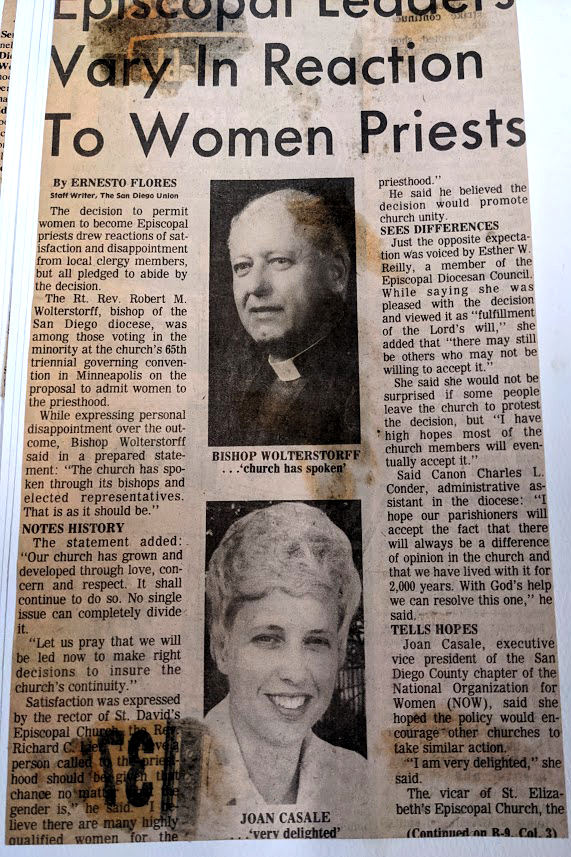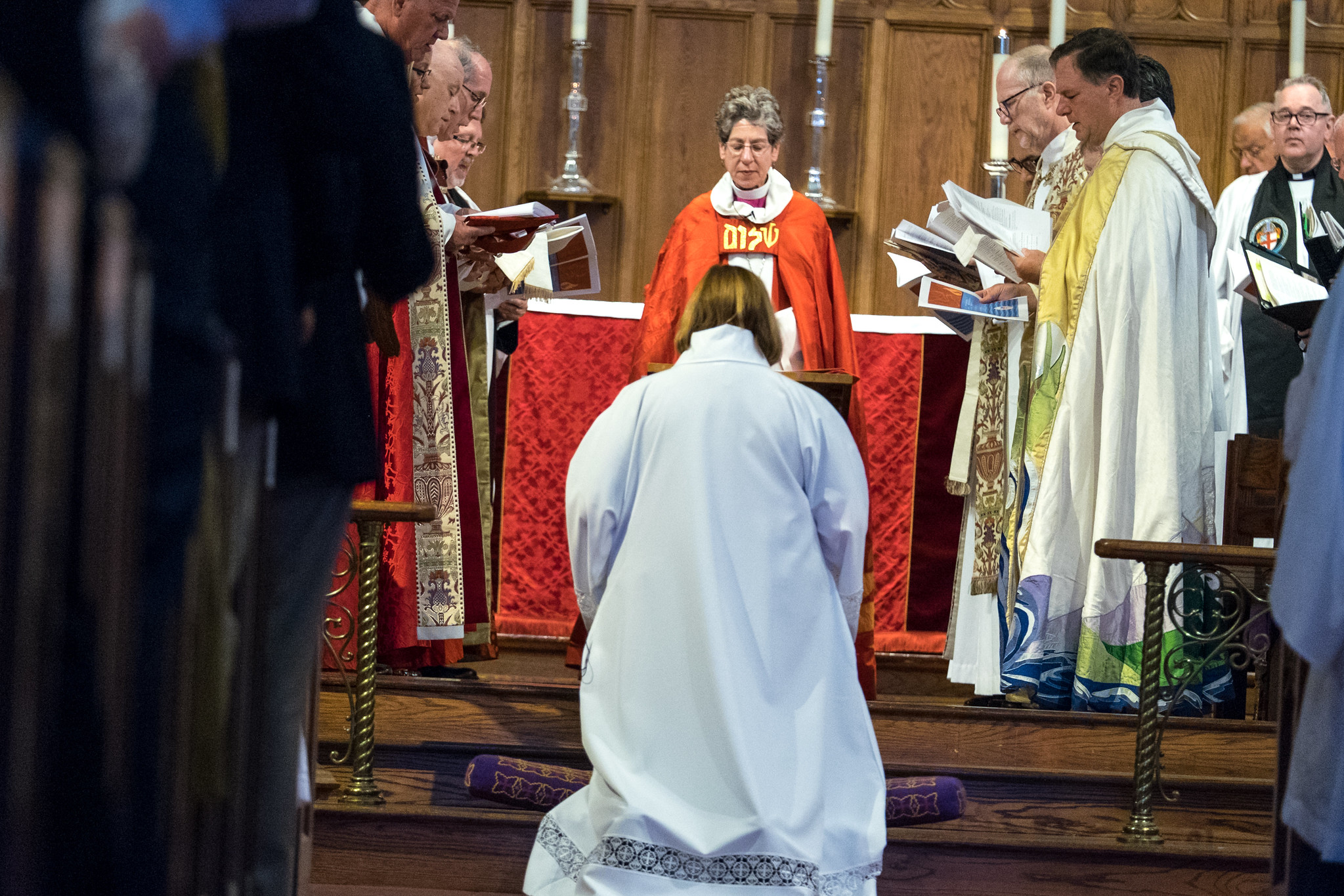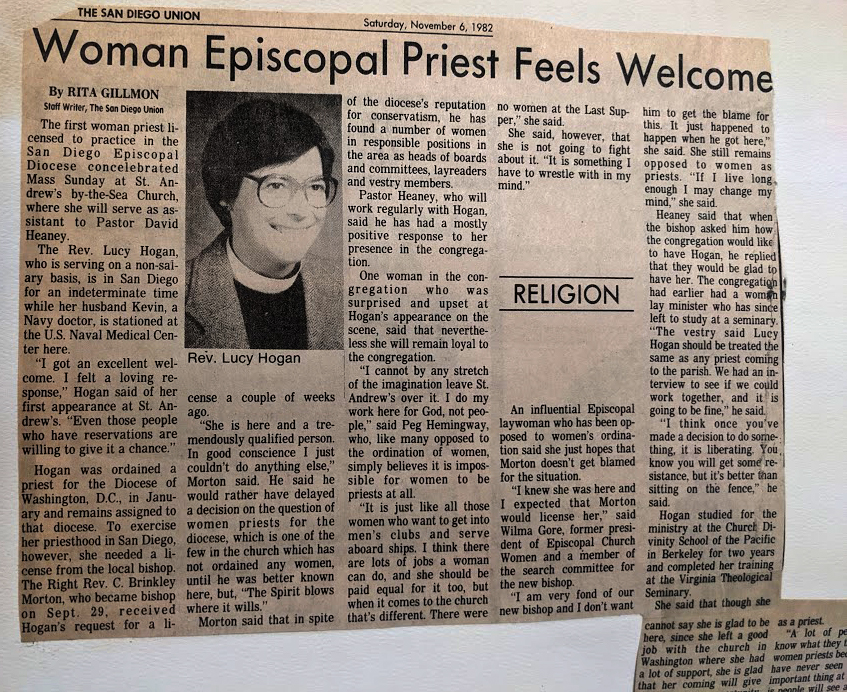Our History: Celebrating Women in Ordained Ministry
There’s a picture floating around our diocese from last February’s ordination: Bishop Susan is standing in front of ordinands Heather Lawrence, Christina Miller, and Dawn Stary. The Rev. Canon Gwynn Lynch, Canon to the Ordinary, and the Ven. Cindy Campos, Archdeacon of the Diocese, stand beside the bishop. The Dean of St. Paul’s Cathedral, The Rev. Penny Bridges, and The Rev. Canon Allisyn Thomas can be seen in the background.
Seeing an image so filled with women at different points of their vocational journey – women who represent the highest levels of authority in our diocese with women beginning their own clerical journey – and also knowing the abundant representation that women have held in our diocese in recent history– it can be easy to forget that this episcopate is the first chapter in our diocesan history that this picture is possible.
To recap our history as a diocese and as the broader Episcopal Church:
- In 1976, General Convention officially approved the ordination of women into the priesthood and the episcopate. The first women to be ordained in the Episcopal Church happened two years earlier, with the Philadelphia Eleven.
- In 1982, The Rev. Patricia Backman of St. David’s Episcopal Church was the first woman to be ordained in the Diocese of San Diego and as a vocational deacon.
- In 1984, The Rev. Patricia Bush of St. Matthew’s Episcopal Church was the first woman to be ordained as a priest in our diocese. (The Rev. Lucy Hogan was the first woman priest to be licensed to serve in our diocese, and was ordained elsewhere.)
- In 2019, The Rt. Rev. Dr. Susan Brown Snook was consecrated as the first woman Diocesan Bishop in the Episcopal Diocese of San Diego.
All of these “firsts” serve as benchmarks of change towards a more abundant, diverse definition of who belongs in the Episcopal Church, who we as a collective institution believe is fit to lead us, and who we are ready to follow and learn from.
 This is a change that did not come gently to the Episcopal Church. Proponents of the canonical change to include the possibility of women in ordained ministry were dismissed by some as being divisive and stirring up discord.
This is a change that did not come gently to the Episcopal Church. Proponents of the canonical change to include the possibility of women in ordained ministry were dismissed by some as being divisive and stirring up discord.
A great percentage of congregations left the Episcopal Church over the decision for the ordination of women (combined with disagreements over revisions to the Book of Common Prayer). Coalitions existed to advocate against the ordination of women. One of these coalitions wrote and published in a local religious newspaper a letter of protest regarding the ordination of Rev. Bush in 1984.
An article in the Union Tribune written by Rita Gillmon in 1984 indicates that some even anticipated protestors being onsite at Rev. Bush’s ordination ceremony held at St. Andrew the Apostle. In the same article, the Rt. Rev. C. Brinkley Morton, bishop of the diocese at the time of Rev. Bush’s ordination, was quoted to say, “he hoped ‘there will be charity and understanding for those who differ on the question of women priests” – a reminder that as followers of Christ, we all seek to commune with each other at the same proverbial table.
The Rev. Richard Lief, then rector of St. David’s Episcopal Church, is reported saying, “I believe a person called to the priesthood should be given that chance no matter what their gender is. I believe there are many highly qualified women for the priesthood.”
Now, the Episcopal Diocese of San Diego is used to women in leadership. The Rt. Rev. Katharine Jefforts Schori, who served as the first female Presiding Bishop in the Episcopal Church, stepped in to aid our diocese as an assisting bishop until the election and consecration of a new bishop, our first female Bishop Diocesan, The Rt. Rev. Dr. Susan Brown Snook.
We love a good hero story, and certainly, these women have earned the recognition – being The First of anything comes with its own pressure and level of scrutiny. But for every Patricia, Patricia, and Susan, there are thousands of women in the history of our diocese who have helped shape our identities as individuals, as congregations, and as a whole.
pressure and level of scrutiny. But for every Patricia, Patricia, and Susan, there are thousands of women in the history of our diocese who have helped shape our identities as individuals, as congregations, and as a whole.
Who are the women who have ministered to our children; who are the women who have ministered to our adults who may sometimes act like children? Who are the women who have nourished us with literal food, and the women who have fed us with spiritual food? Who are the women who have formed us for ministry through their various temperaments, talents, and contexts?
From women who wear clerical shirts and collars to women whose ministry is best served in a t-shirt and jeans, who are the women in our own history who have led us to a deeper understanding of the wonderfully vast and varied nature of God?
Take some time this week to celebrate the women who have been a part of our formation and give thanks not just for the things they have accomplished but also for embodying the fullness of everything God has created them to be.
With deep gratitude to John Will, EDSD Archivist and Historiographer, and to all who painstakingly preserve documents in our history.
by
Category: #Advocacy, #Salt and Light, #Worship & Formation
Respond to this:
4 replies to “Our History: Celebrating Women in Ordained Ministry”
Recent Stories
My mother was ordained an Episcopal priest on January 15, 1994, at All Saints’ Episcopal Church in Beverly Hills. I was ten years old, and her being ordained wasn’t odd […]
In December 2023, I received a letter from Julia Ayala Harris, President of the House of Deputies, saying, “I have reviewed your application and, after prayerful discernment, invite you to […]
When we love something, we share it with our friends and family; like a new show on Netflix or a great restaurant in the neighborhood, we can’t help but share […]






Our diocese is blessed by the history of our Church, the workings of the Holy Spirit and the wisdom of our congregations and leaders. It is wonderful to grasp this reality: the trails these women are blazing and the difference they are making. Thanks for gathering these facts and pointing to them during women’s history month.
Not only here but alao the Episcopal Church in the Philippines has a lot of ordained women in the ministry. To God be the glory.
Although I was pleased to see this article, I was very disappointed that there was no mention of Lee Teed or me being the first females in the Diocese of San Diego to be accepted into the Process to go to 3 year seminaries in 1987, be ordained as Transitional Deacons in June, 1990, and Priests in December, 1990. Lee graduated from CDSP and I graduated from Yale Divinity School/Berkeley Divinity School at Yale in 1990. Lee served part-time at St. Andrew’s, Encinitas; I served full time at Good Samaritan, University City. The Rev. Dr. Beverly L. Dexter+, Ret.
Thank you Rachel for this history. I recently attended a showing of the film on the Philadelphia 11 so this is especially on my mind and in my heart as I prepare to preach at the installation of our first woman rector at St. Timothy’s. However there is a hurt in my heart that excitement about women being priests overshadows the first ordinations of women when the 1973 General Convention allowed for deaconesses to be part of the one Order of Deacons along with the men. This was necessary for the women who were then ordained into the priesthood. I count the years of my ordained ministry from the moment I became a deacon. This matters greatly to me since I began serving out my ordination in a diocese that didn’t accept or ordain women into the priesthood for more than twenty years. I represented women in collar in Fort Worth, Texas, for twelve years until I could get back to California and complete my call to be a priest. Please don’t discount the service of deacons or the women who were truly the first to be ordained. Also, note that one of the Deaconesses who had ministered before there was one Diaconate lived out the end of her life at Good Shepherd, Bonita, and her picture hangs in the Library there. Deaconess Dawson was a significant influence on my call to ministry when I met her in the 1960s and learned of her missionary work and time in a Japanese prison camp in WWII.